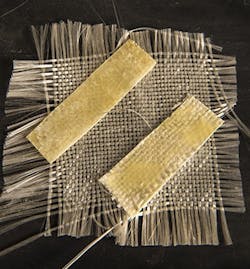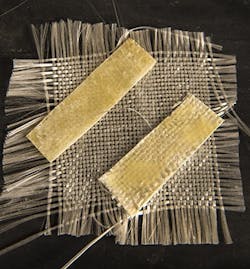Upcycling Promises To Pare Plastics Pollution
Figure 1. Researchers have discovered a method of upcycling polyethylene terephthalate to transform discarded products into hardy composite materials that can be used in commercial and industrial products. Source: Dennis Schroeder/NREL.
A method of plastics upcycling — transforming discarded products into new, high-value materials of better quality and environmental value — could economically incentivize waste plastic recycling and help solve a major pollution problem, say researchers at the U.S. Department of Energy’s National Renewable Energy Laboratory (NREL), Lakewood, Colo.
According to an article in Joule, the NREL team combined reclaimed polyethylene terephthalate (PET), in the form of single-use beverage bottles, with bio-based compounds such as muconic acid to produce higher-value fiber-reinforced plastics (FRPs). Not only are the resulting composites worth more than double the original PET, but the FRPs also exhibit twice the strength and improved adhesion to fiberglass compared to standard petroleum-derived FRP, claim the researchers.
“Knowing that 26 million tons of PET are produced each year but only 30% of PET bottles are recycled in the United States, our findings represent a significant advancement in enabling the circular materials economy,” notes NREL’s Gregg Beckham, one of the primary authors of the paper.
The process also is more energy efficient and less hazardous than standard manufacturing processes for petroleum-based FRPs, says the team. A supply-chain analysis of the FRP materials found substantial energy savings and greenhouse gas emission reductions when compared to the process for producing petroleum-based composites.
The researchers are investigating several next steps. The first involves scaling up the process to make larger composite materials to test their performance for a wider variety of applications such as for use in wind turbines, car parts and other performance materials.
“The current composites are not inherently recyclable at the end of their (hopefully very long) lifetimes,” admits Beckham. So, NREL is investigating how to do the same type of work (combine bio-based building blocks with reclaimed plastics to upcycle them) while also including inherent recyclability at the end of life.
Exploring the effect of bio-based building blocks other than muconic acid in these material formulations is another area of focus.
The team also is doing similar upcycling work with polyethylene, polypropylene, nylons, and polyurethanes. “It is likely that we will have some exciting results on polyethylene coming soon,” hints Beckham.
Many challenges still exist, he acknowledges. “Most importantly, we need help from industry to scale up. We are starting to assemble key partners in this area now and are actively looking for industrial partners to collaborate with. We need to understand better what the lifetime performance and quality of these materials will be, and if these ideas are industrially viable in the first place,” he says.
Another major challenge is accessing bio-based building blocks at large scale. “Bioeconomy research and development tends to focus on scaling up production of molecules for which there is an immediate or near-term use, and for many building blocks, this is market driven. Today, it is difficult to access large quantities of muconic acid at the ton scale from a bio-based building block, but it’s possible that more easily accessible bio-based building blocks could lead to similar properties, and that’s why we’re both actively looking for industrial engagement and also researching additional compounds now at the bench scale,” explains Beckham.
“We are excited about the idea of combining bio-based building blocks with reclaimed, low-value waste plastics, and we think there is an exciting R&D future as well as potentially scalable solution for plastics upcycling in this direction,” he concludes.
Meanwhile, industry is increasing efforts to address the problem of discarded plastics (see: “Industry Tackles Plastics Plague.”).

